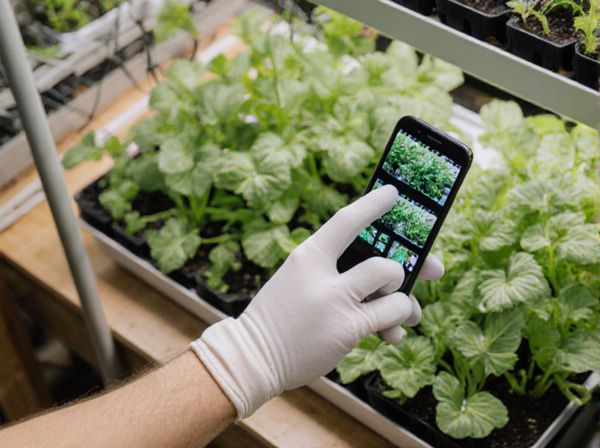
Hydroponics vs Soil Cultivation Illustration
Hydroponics offers precise control over nutrient delivery and water usage, leading to faster plant growth and higher yields compared to traditional soil cultivation. Soil cultivation relies on natural processes and microorganisms, which can improve soil health and biodiversity but may result in slower growth rates. Both methods have unique advantages, with hydroponics suitable for space-efficient urban farming and soil cultivation preferred for organic and sustainable practices.
Table of Comparison
| Aspect | Hydroponics | Soil Cultivation |
|---|---|---|
| Growth Rate | Faster growth, up to 25-50% quicker | Slower growth due to nutrient variability |
| Water Usage | Uses 70-90% less water than soil | Higher water consumption, prone to runoff |
| Space Efficiency | High-density vertical and horizontal setups | Requires more ground space |
| Nutrient Control | Precise nutrient delivery via water solution | Dependent on soil quality and amendments |
| Pest & Disease Risk | Lower risk with controlled environment | Higher risk due to soil-borne pests and diseases |
| Setup Cost | Higher initial investment for equipment | Lower setup cost using natural soil |
| Maintenance | Requires monitoring of water and nutrients | Routine soil tilling and fertilizing needed |
| Crop Yield | Typically 20-30% higher yields | Yield varies with soil fertility and conditions |
| Environmental Impact | Reduced soil erosion and nutrient runoff | Potential for soil degradation and pollution |
Introduction to Hydroponics and Soil Cultivation
Hydroponics is a soil-less cultivation method where plants grow in nutrient-rich water solutions, enabling faster growth and higher yields in controlled environments. Soil cultivation relies on traditional earth-based planting, providing natural microbial activity and nutrient cycling essential for crop development. Both methods offer distinct advantages, with hydroponics optimizing resource use and soil cultivation supporting ecological balance.
Key Differences Between Hydroponics and Soil-Based Gardening
Hydroponics uses nutrient-rich water solutions to grow plants without soil, enabling faster growth rates and higher yields in controlled environments. Soil-based gardening relies on natural soil composition and microbial activity, which supports plant health but can be affected by pests and varying nutrient availability. Hydroponics demands precise monitoring of pH and nutrient levels, while soil cultivation benefits from organic matter and soil structure for root development.
Equipment and Setup Requirements
Hydroponics systems require specialized equipment such as nutrient reservoirs, pumps, grow lights, and inert growing media like coconut coir or rockwool to optimize plant growth without soil. Soil cultivation demands traditional tools including hoes, tillers, and irrigation systems but has minimal reliance on artificial supports or nutrient delivery mechanisms. Initial setup costs and technical knowledge for hydroponics are typically higher, emphasizing precision control of pH and nutrient levels compared to the more straightforward, natural soil-based setups.
Nutrient Delivery Systems
Hydroponics utilizes a nutrient delivery system that directly supplies water-soluble minerals to plant roots, ensuring precise control over nutrient concentration and uptake efficiency. Soil cultivation relies on natural nutrient cycles within the soil matrix, where microorganisms break down organic matter to release essential nutrients, but this process can be slower and influenced by soil quality. The efficiency of hydroponic nutrient delivery systems often results in faster growth rates and higher yields compared to traditional soil-based methods.
Water Usage and Conservation
Hydroponics uses up to 90% less water than soil cultivation by recirculating nutrient-rich solutions directly to plant roots, minimizing water waste. Soil cultivation relies on large water quantities absorbed by soil and lost through evaporation and runoff, making it less efficient. Efficient water usage in hydroponics supports sustainable greenhouse production by conserving water resources and reducing environmental impact.
Plant Growth Rates and Yields
Hydroponics systems enable faster plant growth rates and higher yields compared to traditional soil cultivation by delivering nutrients directly to the roots in a controlled environment. Studies show hydroponically grown plants can mature up to 25-50% quicker, with crop yields increasing by 20-30% due to optimized nutrient uptake and reduced pest exposure. This method also minimizes water usage by up to 90%, facilitating sustainable production within greenhouse settings.
Disease and Pest Management
Hydroponics significantly reduces the risk of soil-borne diseases by eliminating soil as a medium, enabling cleaner and more controlled growing conditions in greenhouses. Pest management in hydroponic systems relies heavily on integrated pest management (IPM) strategies and biological controls, minimizing chemical use and promoting plant health. Conversely, soil cultivation often faces challenges with soil pathogens and pests, requiring crop rotation and soil treatments to manage disease outbreaks effectively.
Cost Analysis: Initial Investment and Maintenance
Hydroponics systems typically require a higher initial investment due to specialized equipment such as pumps, nutrient solutions, and grow lights, whereas soil cultivation demands more affordable tools and organic inputs. Maintenance costs for hydroponics include electricity for water circulation and nutrient replenishment, but the system benefits from faster plant growth and higher yields, potentially offsetting expenses over time. Soil cultivation incurs ongoing costs for fertilizers, pest control, and tilling, with variable output and longer growth cycles affecting overall cost efficiency.
Environmental Impact and Sustainability
Hydroponics reduces water usage by up to 90% compared to traditional soil cultivation, minimizing resource depletion and promoting sustainable agriculture. It also decreases the need for chemical fertilizers and pesticides, lowering the risk of soil contamination and runoff into water bodies. Soil cultivation, while supporting biodiversity and natural ecosystems, often results in higher greenhouse gas emissions and soil degradation due to intensive farming practices.
Choosing the Best Method for Your Greenhouse
Hydroponics offers precise control over nutrient delivery and water usage, making it ideal for maximizing yield in limited greenhouse space. Soil cultivation supports natural microbial ecosystems that enhance plant health and flavor, beneficial for crops requiring traditional growth cycles. Selecting the best method depends on crop type, resource availability, and desired growth speed within your greenhouse environment.
Hydroponics vs Soil Cultivation Infographic

 gardendif.com
gardendif.com